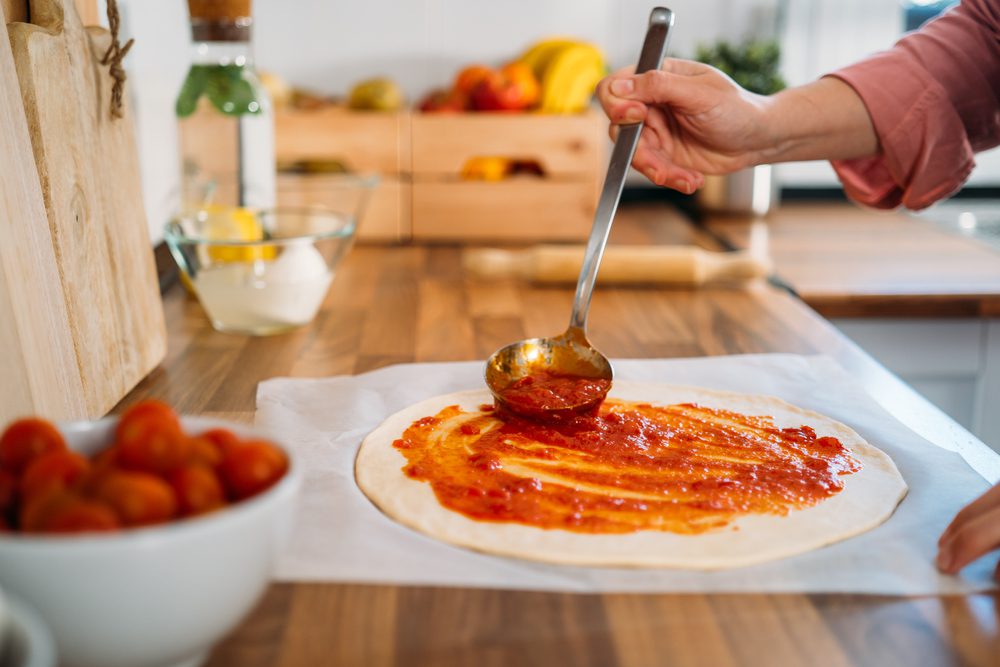There’s one thing that makes most of us happy, and we usually don’t give it the credit it deserves. It’s not love, money, or a fancy car. It’s something less abstract and simpler. Can you guess what is?
Food. Well, obviously we all need food to survive, but food can do more than this. It can bring you joy, especially when you’re the one who cooks it.
However, emotional eating isn’t always a good thing – especially if you’re a pizza or fast food enthusiast. Most of the time, these foods do more harm than good causing addiction and increasing our long-term risk for serious illnesses like heart disease, diabetes or neurological conditions.
But does that really mean we should give up on the few pleasures we still have left in a world struggling with illness, economic crisis and depression?
Absolutely not!
Today, we’re going to have a look at 7 simple ways you can upgrade your favorite pizza and turn it into a healthy choice that improves your immunity all while maintaining that unforgettable flavor.
How to make your pizza healthier

1. Add extra veggies
Although pizza is a ready-made product, there are endless ways to customize it for maximized health benefits. In fact, we should think of this wonder food as a canvas that we can paint any way we like.
Amy Kimberlain, RD, spokesperson for the Academy of Nutrition and Dietetics in Miami, explains that adding as many vegetables as possible on your pizza increases your vitamin and mineral intake – both of which are essential for a strong immune system.
According to her, the best options for the classic red sauce pizza (in terms of flavor) are peppers, mushrooms, tomatoes and onions. Even adding some extra basil can make a positive difference in the nutritional benefits of your final product!
Bell peppers, for example, are an excellent source of fiber, as a single cup gives you more than 11% of your daily recommended value. Fiber provides extra satiety to your meal while regulating digestive functions, as per Mayo Clinic.
Mushrooms are also on top of the list due to their high vitamin B3 content. In fact, the USDA points out that a single cup of raw mushrooms offers 21% of your daily value.
2. Go for a thin-crust pizza
The pandemic year of 2020 has triggered many trends we didn’t expect, one of them being cooking at home. Regardless if you’re into this trend or would rather opt for takeout, opting for a thin crust can make your pizza two times healthier without sacrificing its flavor.
How does this work? Well, Angela Lemond, RDN, Texas-based co-owner of Lemond Nutrition, explains that it’s a psychological trick: eating a thin crust means you’ll get more veggies instead of just filling your stomach with bread from the crust.
Yes, I’m mentioning veggies again because they are in fact a key element of staying healthy in the long run. For instance, this study published in the Journal of American Heart Association revealed that those who eat (mostly) plant-based diets have a lower risk of cardiovascular diseases.
Furthermore, eating a thin-crust pizza can reduce your total sodium intake – another potentially dangerous ingredient when consumed excessively.

3. Pick lean protein sources
Yes, pepperoni and ham are incredibly tasty and some may even argue that they’re essential for the perfect pizza. But is their flavor worth increasing your risk of cardiovascular disease and diabetes?
Probably not.
Kimberlain recommends everyone to limit the intake of processed meats as much as possible to reduce unhealthy fats and sodium. Unfortunately, this includes sausage, bacon and pepperoni. The same recommendation is also issued by the American Heart Association – and salami is included on their list as well.
If you just can’t stand the thought of a vegetarian pizza, you can choose one with lean meat such as chicken breast or seafood to keep it healthy.
4. Add a healthy side to your pizza
I know how exciting is pizza night especially if you haven’t had one in a while. But why make it all just about pizza?
Although pizza itself is one of the most satiating meal choices out there, pairing it with a healthy side dish can increase the overall nutritional benefits. For example, Kimberlain suggests opting for a veggie appetizer made of cucumber, carrots or celery sticks mixed with a yogurt-based ranch.
Even if you choose a pizza without any veggies on top, choosing this appetizer gives you the certainty of getting all the vitamins and minerals you need.
5. Don’t rush it
This is perhaps one of the biggest traps people fall into: eating like there’s no tomorrow.
I know the comparison is a bit ironic considering the uncertain future awaiting for us, but part of enjoying all the flavors of a meal is to just go through it slowly: embrace the taste, and enjoy each bite.
Eating slowly also provides an important number of health benefits. In simple terms, your body needs some time to take in the food you ingest and realize when it’s full.
If you’re eating too fast, your body doesn’t send signals that it’s full to the brain and you end up eating more than you actually need. This can also lead to bloating, nausea and other unpleasant post-meal symptoms.
Furthermore, eating slowly allows you to enjoy your company more, which has plenty of health benefits too. For example, this report from Harvard Health Publishing says that social bonds and good relationships increase longevity while improving the well-being of those already diagnosed with long-term health conditions.

6. Add extra red sauce
If you like the red sauce flavor on pizza, then you’re in luck! This ingredient is filled with important nutrients such as vitamins A and C; more precisely, just ¼ cup of a tomato-based sauce can give you 8% of your DV for vitamin C and 2% of the DV of vitamin A.
Both vitamins can strengthen your immune system significantly, with vitamin A also maintaining healthy vision in the long run.
Additionally, red sauce contains lycopene, an antioxidant that can reduce your risk of serious diseases such as stroke and cancer, as per Harvard Health Publishing data.
7. Beware of the cheese
Well, not in the literal sense – but the cheese you pick for your pizza can literally make or break a healthy recipe.
Kimberlain points out that cheese provides you with valuable protein and calcium; however, many options are also overloaded with saturated fat or sodium. She recommends enjoying a 2% mozzarella or skim ricotta.
If you’re not a fan of either option listed above, you can just pick your favorite cheese and ask for a less amount.
Pizza may not be the healthiest option, especially when it comes to pizza that has plenty of salty meats, cheese, and other high-calorie toppings. However, if you love eating pizza, go for it! It won’t do any harm if you indulge yourself with a few slices from time to time. After all, life’s too short to not eat the foods that you love, right? A great and healthier option would be to make your own pizza at home. This way you can choose exactly the ingredients you like (low-sodium cheese, for instance).
Here’s a recipe book that may inspire you!
You may also want to read 12 Effective Acid Reflux Remedies You Can Make at Home.













